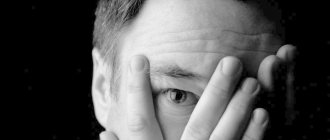For many, a dog is a loyal friend and family member. But there are people who are terribly afraid of these animals. The fear of dogs as a phobia is in no way connected with the usual human precautions. The fear in such people is so strong and uncontrollable that it causes panic attacks and can harm the person. Cinemaphobes often withdraw from society and are afraid to go out. And against the background of this psychological disorder, other phobias may appear over time, which makes life unbearable.
What is the fear of dogs called?
What is the correct name for fear of dogs? This concept comes from the Greek κυν - dog and φόβος - fear. Cynophobia is characterized by an inexplicable, uncontrollable fear of dogs.
This pathology has subtypes:
- adactophobia - fear of being bitten;
- Rabiephobia - fear of contracting rabies.
The fear of dogs appears not only in close proximity or contact with an animal, but also when watching films, pictures, videos with it. On average, there are 1.5–3.5% of film phobes worldwide. For the most part, this figure consists of children and young people under 30 years of age.
If the pathology is not treated in a timely manner, then the phobia of fear of dogs progresses. Cynophobia is often observed in hypochondria, senestopathy, and schizophrenia. The risk of getting sick increases with significant overstrain of the nervous system, neuroses, depression, and breakdowns.
How to treat cynophobia in an “advanced” state
In its advanced state, a phobia can cause inconvenience in a person’s life, for example, reduce communication with friends, deprive them of the opportunity to attend public events (exhibitions, holidays), and travel.
In the severe stage, the help of a specialist is required who will conduct not only a psychotherapy session, but also drug treatment (can last from six months to a year). The patient is prescribed tranquilizers (Clonazepam, Phenazepam), SSRI antidepressants (Cipralex, Sertraline). In most cases, experts prescribe Moclobemide, which helps relieve panic attacks.
Distinctive features of a kinophobe
A person dealing with a phobia does not show aggression towards the animal; on the contrary, he avoids it. Those who pretend to be falsely afraid of dogs can cover up their sadism, carnage, and psychopathy associated with pets with imaginary protection from four-legged animals. Therefore, it is necessary to differentiate true pathology from pseudo-disease.
Also, people who neglect or avoid dogs for their own or religious reasons should not be considered kinophobes. To make an accurate diagnosis, a comparative analysis is carried out:
- anxiety appears at the sight of corresponding paraphernalia, pictures or animals;
- a person avoids meeting a four-legged animal, both realistically and hypothetically;
- identify other mental diseases;
- signs of panic fear should be primary, and not a consequence of delirium or obsessive syndrome.
Risk factors
It is not always possible to focus on the exact moment when fear begins and find out what provokes it. The fear may become extremely painful due to a dog attack, or it may develop gradually over time. There are situations or predispositions (such as genetics) that put a certain person at higher risk of developing cynophobia.
Specific risk factors include:
- Experience. Have you ever had a bad experience with dogs in the past? Perhaps the dogs were chasing you or they bit you? Due to traumatic events, your chances of developing cynophobia increase significantly.
- Age. Phobias affect both children and adults. In some cases, a specific phobia may first manifest itself by the age of 10. But this also happens later.
- Family. If one of your loved ones has a phobia and anxiety, then you are more prone to irrational fears. You may genetically inherit a phobia or adopt a certain pattern of behavior over time.
- Character and temperament. The chances of developing a phobia increase if you are a sensitive person.
- Information. Cynophobia may develop if you become aware of bad situations involving dogs. For example, because of reading a story about a dog attacking a person, a phobia may develop.
Causes of phobic disorder
It is not enough to know what a phobia/fear of dogs is called; you also need to understand the causes of the pathology. The main ones include:
- heredity. Often various phobias are transmitted genetically;
- overprotection. When parents constantly protect the baby from contact with an animal, saying that the dog is sick or might bite;
- inferiority. A person understands that he cannot be faithful, affectionate, and devoted like a pet.
Moreover, in the presence of the above problems, the provoking factor may be hormonal imbalance, difficulties in life, chronic stress, and certain medications.
By the way, studies have shown that the main version about the development of pathology as a consequence of a bite is groundless. Those who have experienced dog aggression rarely become cinemaphobes. Gradually, they can only exercise caution when they see large breeds of dogs or in case of a real threat.
Symptoms
Researchers estimate there are more than 62,400,000 dogs. So the chances of running into a dog are quite high. Symptoms of cynophobia occur when there are dogs nearby, and for some, just thinking about these animals is enough to trigger panic.
The symptoms associated with a specific phobia can vary greatly from person to person. No two people experience fear to the same degree. Symptoms can be physical, emotional, or a combination of both.
Physical symptoms include:
- labored breathing
- cardiopalmus
- chest pain or heaviness
- trembling in the body
- dizziness
- stomach upset
- alternating sensations of hot and cold
- sweating
Emotional symptoms include:
- attacks of panic or anxiety
- an overwhelming need to escape a situation that causes fear
- self-detachment
- loss of control
- feeling like you might die or pass out
- feeling powerless in the face of your fear
Children also exhibit specific symptoms. When in contact with the object of his fear, the child may:
- hysterical
- cling to an adult
- sob
For example, young children may generally refuse to leave an adult's side if there is a dog nearby.
Manifestations of cynophobia
Dog phobia is the name of a disease that manifests itself in uncontrollable panic at the sight of a four-legged animal. Such a person may change his route if there is a potential threat ahead. The irrationality of behavioral reactions largely depends on the severity of the pathology. Fear of dogs makes us “climb trees” even from small harmless dogs.
Vegetative manifestations include:
- tachycardia;
- trembling;
- changes in blood pressure;
- pallor of the integument;
- increased sweating;
- frequent urination;
- discomfort in the sternum;
- muscle structure tension;
- dry mouth;
- difficulty breathing.
In advanced cases, the fear of dogs provokes panic attacks.
On the part of psychological discomfort, there is irritability, wariness, deliberation, constant mental replay of unpleasant events that do not exist or happened in the past.
Causes of development of cynophobia and its symptoms
After reading the first section, any person who is afraid of dogs may consider himself nervously ill. That’s how people are designed, we like to impose on ourselves what doesn’t exist. If your fear of dogs is really strong or seems subconscious to you, it is worth trying to find the reason for it. Based on medical practice, the roots of cynophobia stretch from childhood or adolescence; it is during these periods that the human psyche is most vulnerable. Most often, fear of dogs develops against the background of:
- Inheritance of the behavioral habits of parents - this is written above, the mother is afraid of the dog and imposes fear on her child.
- His own complexes - in fact, a prepared, calmly acting person is capable of defending himself when attacked by a dog and even killing a four-legged animal with his bare hands. However, a person may consider himself weak, cowardly, clumsy, and this will give rise to fear of four-legged animals. One’s own complexes often give rise to false cinemaphobia.
- Physiological pathologies - very often deaf and mute people are afraid of dogs and not only them. They are afraid of an unexpected attack - this is an instinct. This group also includes people with disabilities or delayed development.
- Experienced stress - as statistics show, this factor is the cause of a phobia extremely rarely. A child who is afraid of dogs after being attacked by a stray pack does not seem strange. A mother who has survived the threat of rabies infection is also understandably worried about her offspring.
Can a dog sense human fear?
Many people think about how to overcome the fear of dogs, because, according to popular belief, four-legged animals feel this due to the release of adrenaline at this moment. In fact, the hormone does not activate receptors responsible for aggression, which is confirmed by many specialized studies.
Dogs react not to the fear itself, but to the client’s behavior. He begins to worry and get nervous, this manifests itself in gestures, facial expressions, movements, and screaming. It is this process that causes aggression. Therefore, you need to fight not with the release of adrenaline, but with your own emotions.
conclusions
Cinemaphobia is a fairly common problem, and psychotherapists successfully work with it. The fear of dogs is pathological, because despite the fact that this is an animal, it is a predator and “we don’t know what’s in their head” - this phobia belongs to the category of social ones.
The dog is a participant in the social life of people, appears as the hero of countless classic books, participates in military operations, serves in the police and helps in rehabilitation. This is an intelligent, social animal. What's in a dog's head? There is hardly anything more terrible than what a person is capable of, and it is by no means easier to get into his head.
How to behave when you see danger?
When thinking about how to get rid of the fear of dogs, you should also study the rules of behavior around an aggressive animal. Attention should be paid to:
- sight. In order not to provoke the dog, you should avoid direct eye-to-eye contact;
- calmness. The animal will not like sudden movements of arms or legs. Running is also a bad option;
- facial expressions A grin or grin can evoke associations with the display of fangs and serve as a signal for battle;
- other subject. If you carefully throw something to the side, you can get the dog’s attention to switch to the object.
If the dog does attack, then you need to try to neutralize it with a kick to the nose.
What does an neglected phobia lead to?
To avoid encountering dogs, the patient changes his route to work, even if it is much longer. The patient goes to another store, changes his hobbies and interests in such a way that the chance of meeting a dog is minimal. If dogs walk near the house, then the cynophobe does not go outside until the animals leave. In advanced stages, the patient locks himself at home, orders food to be taken home, and finds remote work. If someone he knows has dogs, he stops communicating with these people.
Ways to get rid of a phobia
Ways to get rid of the fear of dogs:
- work with a psychologist;
- hypnosis;
- drug therapy.
The duration of treatment can last about a year, it depends on the desire, actions of the client himself and on how much the phobia of dogs has “paralyzed” the psychological space.
Antidepressants and tranquilizers are prescribed as medications. Such drugs have a number of side effects, especially in case of overdose, so only a specialist can prescribe and monitor the treatment process.
Of the total number of patients with cynophobia, about 10% need the help of a psychotherapist. However, the experience of a specialist is very important. Being in this position, the client is not always ready to leave his home to seek salvation from the outside, so you can contact a specialist online, for example, psychologist-hypnologist Nikita Valerievich Baturin.
Features of dealing with dog fear
Fear of dogs can be treated with:
- image processing. The client looks at the photos of the dogs, sharing his emotions with the specialist;
- transformation methods. At the moment of contact with an animal, you need to mentally transfer yourself into the role of an object that is not of interest to the dog;
- working through positive facts. The specialist teaches you to treat your pet as a friend. To do this, watch relevant films and read the necessary literature;
- contact with the puppy. Unlike the big dog, this creature looks cute, helpless, harmless. This tactic can help overcome panic.
Phobia in a child
Children tend to be afraid of things that seem trivial to adults. A very big part of this fear is the fear of dogs. If the phobia does not go away, then very soon it can develop into a real disease.
When communicating with a baby, you should not devalue or ridicule his fear. Attempts to forcibly reconcile a child with a pet, for example, by persuading him to pet him, can result in an even deeper deepening of the problem. He will not stop being afraid, but on the contrary, he will still consider the people closest to him as traitors.
Therefore, the best option would be to contact a psychologist-hypnologist to resolve the situation. In this case, overcoming the fear of dogs will be done with gentle measures, through fairy tales and art therapy.
If the baby does not have panic fear, then you can offer to get a puppy. The little pet will grow up with the baby, giving him a lot of positive emotions. At the same time, you should not buy a four-legged animal without the child’s knowledge; everything should happen with the child’s consent.
What you can do yourself to overcome a phobia
A person suffering from cynophobia must learn to distract himself from obsessive, disturbing thoughts. To do this, it is useful to find an exciting hobby and devote time to it every day.
You can place an image of a dog in the most visible place and look at it every day, imagining yourself as the owner of the animal. After the pictures stop causing panic attacks, you can move on to communicating with dogs - it’s best to start with small and harmless puppies.
Independent measures to combat cynophobia
How to get rid of the fear of dogs yourself:
- Review your diet. An incorrect menu leads to disruptions in the balance of carbohydrates, proteins, fats, vitamins and minerals, which provokes disruption of the functionality of the central nervous system and brain. Physiologically, this is expressed by anxiety. A diet for fear of dogs is aimed at increasing the number of carbohydrates in the diet. They secrete tryptophan, which is converted to serotonin.
- Normalize sleep and rest patterns. Mental fatigue is no less dangerous for the brain. You need to sleep 8–10 hours. If mental work predominates, then physical activity should be introduced in your free time. It is better to avoid delays at work and additional work at home.
- Workout. The type does not matter, it can be swimming, gymnastics, athletics or any other. Sports walking in the fresh air also helps eliminate anxiety and improve central nervous system activity.
- Find a hobby. Doing what you love improves your mood, self-esteem, and distracts you from bad thoughts.
- Take time for self-discovery. Daily training in this field can bring considerable results. Self-improvement and knowledge of your spiritual self allows you to find harmony of body, soul, mind, reveals hidden talents, and brings you closer to the world around you.
- Work on your consciousness. You need to try to imagine yourself as the owner of a dog. By gradually cultivating it in your imagination, you can raise a large and strong pet, but with good thoughts and morals.
- Find a weak point in the subconscious. In psychological practice, this exercise is called the “Achilles heel.” The principle of working on yourself is to compare associations in the presence of fear. That is, a person must explain what exactly he is afraid of when he sees a dog, and what he feels at that moment, what he wants, who in his mind can help solve the problem. Having understood these principles, a scenario is built for a meeting between a film-phobe and a loved one with an animal. Moreover, in this case, the four-legged one experiences fear, and the “guard” present in the thoughts provides support and protection to the client. Sometimes long training is required before a person can overcome his problem. If you concentrate on your own fear of dogs, then stop the exercise and repeat it at another time.
A phobia of dogs is expressed in a vivid panic fear of a pet. Cinemaphobes avoid not only animals themselves, but also all possible reminders and associations with them. You can overcome fear on your own by changing the principle of life, diet, and playing sports. In case of advanced pathology, a psychologist-hypnologist will help with this. If you ignore the problem, it will unbearably infringe on the person and lead to his isolation from society.
Why does a phobia occur?
Experts have found that most people who have been attacked by dogs do not become film-phobes. People with a stable psyche begin to fear certain breeds or large animals, but they treat puppies with tenderness and can pet the neighbor’s dog. With an unstable nervous system and increased emotional sensitivity, mild anxiety develops into a phobia.
Cynophobia usually develops in childhood, so the causes of the disorder are considered to be the following:
- Parents reacted too emotionally if a dog approached their child.
- The child was forbidden to approach animals, fearing bites, rabies, and diseases.
- Parents and relatives told how they were bitten as children and showed their scars.
Attention! If parents are wary of animals and avoid them, children adopt their behavior and learn to be wary of these animals. Particularly sensitive and emotional children develop an anxiety disorder that turns into a phobia.










